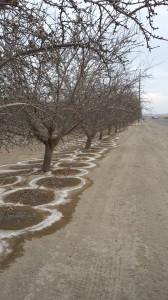
The harvest season is winding down, and in the next few weeks many orchards will be receiving their last irrigations. After the final irrigation of the season, growers should conduct soil sampling to determine any potential issues with sodium, chloride, or boron. These salts are “imported” onto the farm through fertilizers and soil amendments, with the largest amount coming through irrigation water.
There are several videos online that go through the procedure of collecting a soil sample. Here is a link to an article containing this series. When soil sampling for salinity management, varying depths of soil must be collected to determine where the salts have accumulated. Suggested depths are in one foot increments (down to four five feet), but 18 inch increments may also be used. If dealing with soil infiltration issues, it may be of value to sample the top 6″ to determine if there is a soil imbalance.
Almond trees are relatively sensitive to salt. Yields are impacted when average root system salinity increases above 1.5 dS/m, with research indicating a 19% decrease in potential yield with every 1.0 dS/m increase. This yield is due to the osmotic effects of the salts, which basically makes the tree “work harder” for water. If excess salts continue to accumulate within the rooting zone, trees will ultimately uptake the salts and cause tissue toxicity.
If the salt levels within the soil are high, they must be leached from the soil. This process is typically done with applications of water during dormant when evapotranspiration rates are low. More on this topic will be written later, but a great source of information on salinity, management, and leaching programs can be found in “Agricultural Salinity and Drainage” written by Hanson and colleagues (1993), UC ANR publication #3375.


Franz NIederholzer
September 30, 2014Great post, David. This information is relevant up and down the state. It should be of special interest to growers in the Sacramento Valley whose irrigation water source shifted from surface to ground water this year.
David Doll
October 4, 2014Thanks Franz. Just a quick note that I corrected the preferred sampling depth to five feet.
Soil Salinity and Leaching for Almonds - The Almond Doctor
November 14, 2014[…] earlier post discussed proper soil sampling methods. By now, those results should have been received and […]
Salinity Management for Fine Textured Soils - The Almond Doctor
October 18, 2015[…] the leaching program can be determined, there are several analyses that need to be conducted. Soils should be sampled down to five feet. The water that is planned to be used for the leaching program should also be analyzed. It is […]
Post-harvest Leaching Fractions to Refill Soil Moisture Levels - The Almond Doctor
August 16, 2021[…] Christmas, a winter irrigation will be needed. The amount of water depends on the quality of water, the levels of soil salinity, soil type, and irrigation system. After having these variables accounted for, water needs can be […]
Post-harvest Leaching Fractions to Manage Soil Salinity - The Almond Doctor
August 16, 2021[…] Christmas, a winter irrigation will be needed. The amount of water depends on the quality of water, the levels of soil salinity, soil type, and irrigation system. After having these variables accounted for, water needs can be […]